Austins Ferry is the suburb with the most parks in Australia, and a great place to spend a holiday, base yourself for business or just stay for a day or two. To get to our properties you actually drive past historic James Austin Park where the first ferry in Tasmania was located. There is a public launching ramp and yacht club at the end of Austins Ferry road, very close to all our properties and parks all around to walk in.
As a backdrop Austins Ferry has the magnificent Derwent River, wonderful parks and two mountains, yet the area is close to many attractions, shopping and the city. There are shops, takeaways, a wood fired pizzeria within walking distance along the main road and bus route. In nearby Claremont there are both Italian and Chinese restaurants. A modern Woolworths-Safeway shopping complex is one km or 2-3 minutes away by car.
Austins Ferry is steeped in history being the site of the first ferry across the Derwent river before a causeway was built at Bridgewater and there are a number of old buildings in the area including Austins Cottage reputed to be the second oldest in Tasmania still standing. Pictures and attached descriptions of things to do or see in the Austins ferry area are included here.
Austins Ferry is also close to the Glenorchy and Hobart CBD's, some of Tasmania’s largest employers and the best tourist attractions north of Hobart including Moorilla, Cadburys, Alpenrail, Richmond, Bonorong Wildlife Park, Salmon ponds and the Derwent valley. Claremont Golf and Bowls Clubs are both only a couple of kilometres away.
The Cadbury chocolate factory is very close and one of the oldest National parks in Australia, the Mount Field National Park is less than an hour and a half away. Within two and a half hours you can travel to most destinations in the state including the Derwent Valley, Huon valley, Port Arthur and East coast
For more information on the history of Austins Ferry and Claremont go to our free downloads area and about local restaurants and shopping go to restaurants and shopping.
There are also pages about Glenorchy, Hobart and Southern Tasmania.
| Image (Click for higher resolution image if available) |
Description |
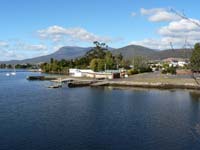
Austins Ferry Yacht Club and public boat launching ramp and jetty |
Around the corner from Derwent Hideaway and at the bottom of the hill from Derwent Retreat are the Austins Ferry yacht club and public boat ramp.
Map
100 metres from both Derwent Retreat and Derwent Hideaway |
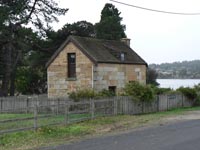
Austin Park and Austin's Cottage |
A small and simple cottage, built by James Austin in 1809 is a couple of hundred metres from Derwent Hideaway.
Austin was a convict who had been transported to Port Phillip in HMS Calcutta in 1803 and then transported to Van Diemen's Land in 1804. His crime was the theft of beehives valued at thirty shillings and he built Austins's cottage on his release. He named the cottage and farm Baltonsborough Cottage and farm after the village of his birth in Somerset, England. In 1816 James Austin and his cousin James Earl established the first trans-Derwent ferry service which remained the main transport route from Hobart Town to Launceston until completion of the Bridgewater causeway in 1838.
Map
100 metres from both Derwent Retreat and Derwent Hideaway |
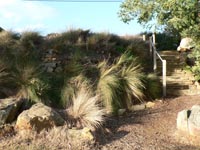
Remains of the Baltonsborough or Roseneath Inn
|
Early last century the Baltonsborough Inn stood on the corner of Harbinger Lane and Austins Ferry Road. In its heyday it was a favourite resort for “holidaying folk” from Hobart Town and it was renowned for its magnificent gardens professed to be unsurpassed in Van Diemens Land.
Map
150 metres from Derwent Retreat and 50 metres from Derwent Hideaway |
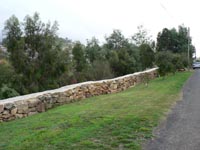
Old Wall Austins Ferry |
The stone wall is located off to the edge of the present Harbinger’s Lane. It has fill against it to around the level of the Lane roadway but it does not act as a road retaining wall.
The wall is on the edge of an escarpment and there are sandstone ledges apparent in the embankment below the wall.
It is considered likely that the wall was constructed on the top of the escarpment around 1815 -1820 by James Austin to prevent livestock falling over the edge.
Map
150 metres from Derwent Retreat and 50 metres from Derwent Hideaway |
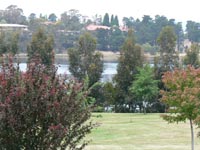
Weston and Shoobridge Park |
Weston Park is amongs the best in Glenorchy and we are pleased to have been the main driving force behind its creation.
Map
150 metres from Derwent Retreat and 50 metres from Derwent Hideaway |
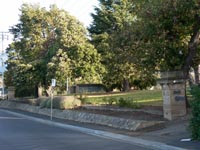
Remains of Roseneath House
|
Roseneath was built by Solomon and Josiah Austin and completed around 1831.
Map
300 metres from both Derwent Retreat and Derwent Hideaway |
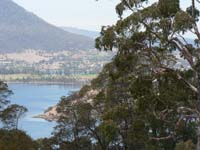
The View from the Top of Poemena Reserve |
The view from the top of nearby Poemena reserve.
Map
.5km (uphill!) from both Derwent Retreat and Derwent Hideaway |
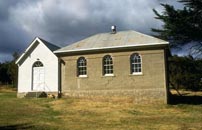
Hestercombe Chapel |
To the north of Derwent Hideaway is Hestercombe Chapel which was built in 1833 by the Hobart merchant, Henry Hopkins. It is the oldest Congregational Church in Australia. This tiny, isolated building has a fireplace (an indication of how cold it gets in winter) and a tiny organ. It is easy to miss as it is grey and unimpressive. There is a simple asceticism to the building.
Map
1.5 km from both Derwent Retreat and Derwent Hideaway |
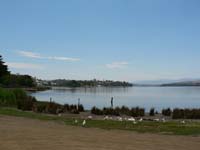
Derwent Retreat and Hideaway from Bilton Bay |
Derwent retreat from Bilton Bay on the same side of the river.
Map
1.5 km from both Derwent Retreat and Derwent Hideaway |
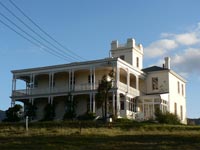
Claremont House |
Claremont or Lady Clark House as it has come to be known was built by the early Pioneer Henry Bilton. Henry came to Tasmania on medical advice in 1825. He became a merchant and later a gentleman farmer. As the first importer of Leicester sheep to Tasmania he gained significant wealth and turned his attention to politics. He was a Justice of the Peace and the Warden of Glenorchy for a number of years; but was unsuccessful in his two attempts to gain entry to the Tasmanian House of Assembly.
Map
2 km from both Derwent Retreat and Derwent Hideaway |
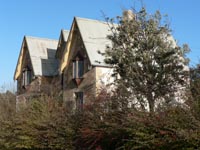
The Black Snake Inn |
About three km to the north of Derwent Hideaway is the Black Snake Inn which was built by the convicts who were constructing the causeway. It was opened in 1833 and operated until 1860.
Map
2 km from both Derwent Retreat and Derwent Hideaway |
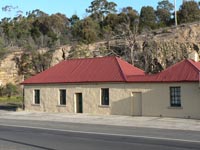
The Old Watch House |
The Old Watch House at the southern end of the Bridgewater causeway, was built by convicts in 1838. Behind the building is the quarry which was used to provide the fill for the causeway. The building contains the notorious solitary cell which was used to punish convicts building the causeway.
Map
2.25 km from both Derwent Retreat and Derwent Hideaway |
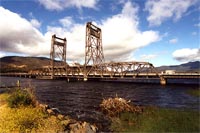
Looking north towards the Bridgewater Bridge which crosses the Derwent river between the towns of Granton and Bridgewater. |
Construction of the Bridgewater causway commenced in 1829. By any measure the Causeway was a remarkable achievement. 1.3 km long, it was built by a workforce of 200 convicts who had been condemned to secondary punishment. These convicts, using nothing but wheelbarrows, shovels and picks and sheer muscle power, shifted 2 million tonnes of soil, stones and clay. It is said that the punishment for not doing a full day's work was to be sentenced to solitary confinement in a cell which was only 2 m high and 50 cm square.
Upon completion of the causeway in 1838, a ferry or punt operated across the deep section of the river. The first bridge at this point across the Derwent was opened in 1849 and the town, which had been laid out on the southern side of the river, was moved (down to the last surveying detail) to the northern bank. It is still possible to see the original town plan near the Old Watch House. The settlement on the southern side of the river was originally known as South Bridgewater but is now known as Granton.
Map
2.25 km from both Derwent Retreat and Derwent Hideaway |













